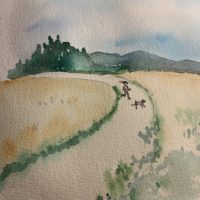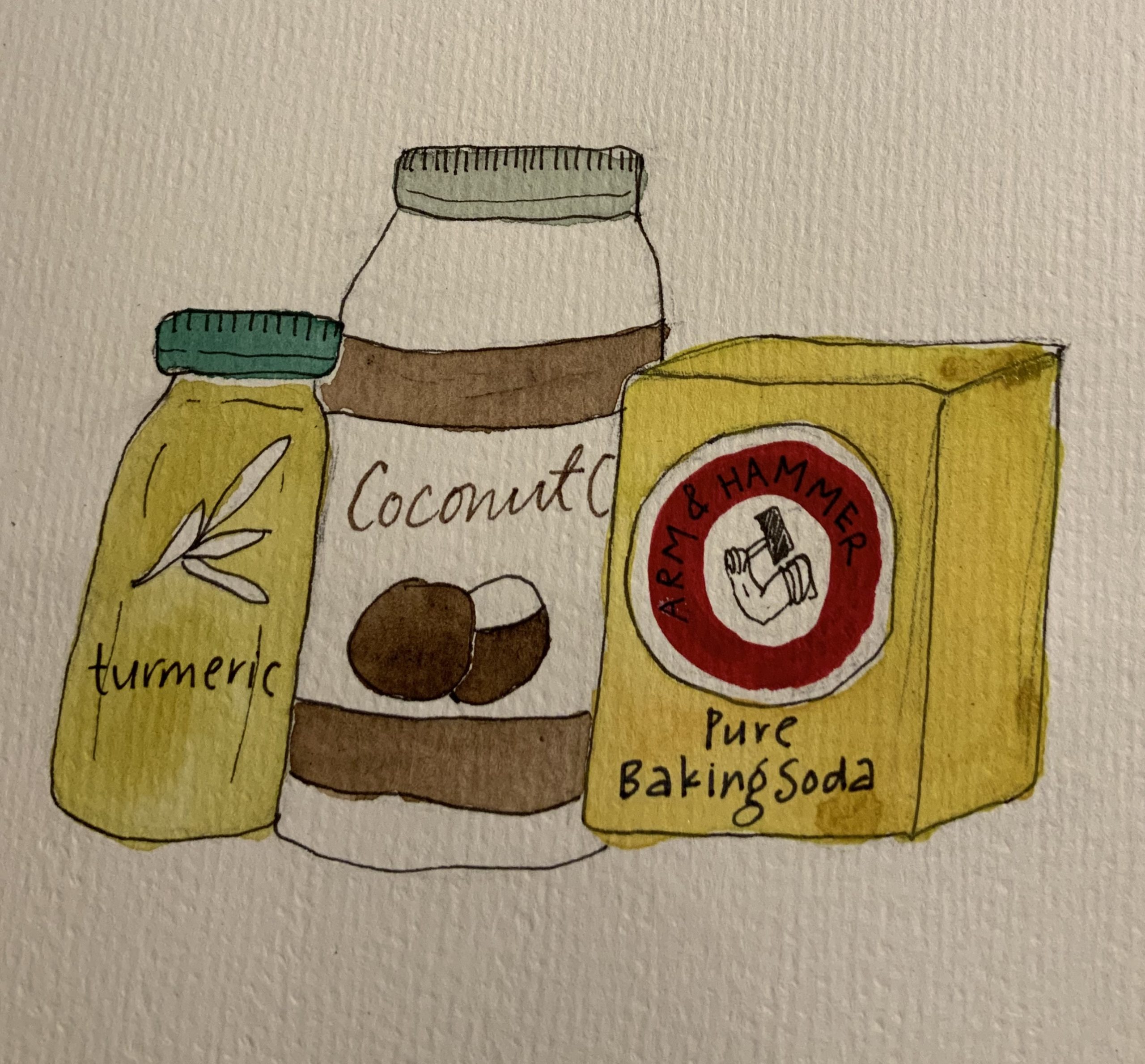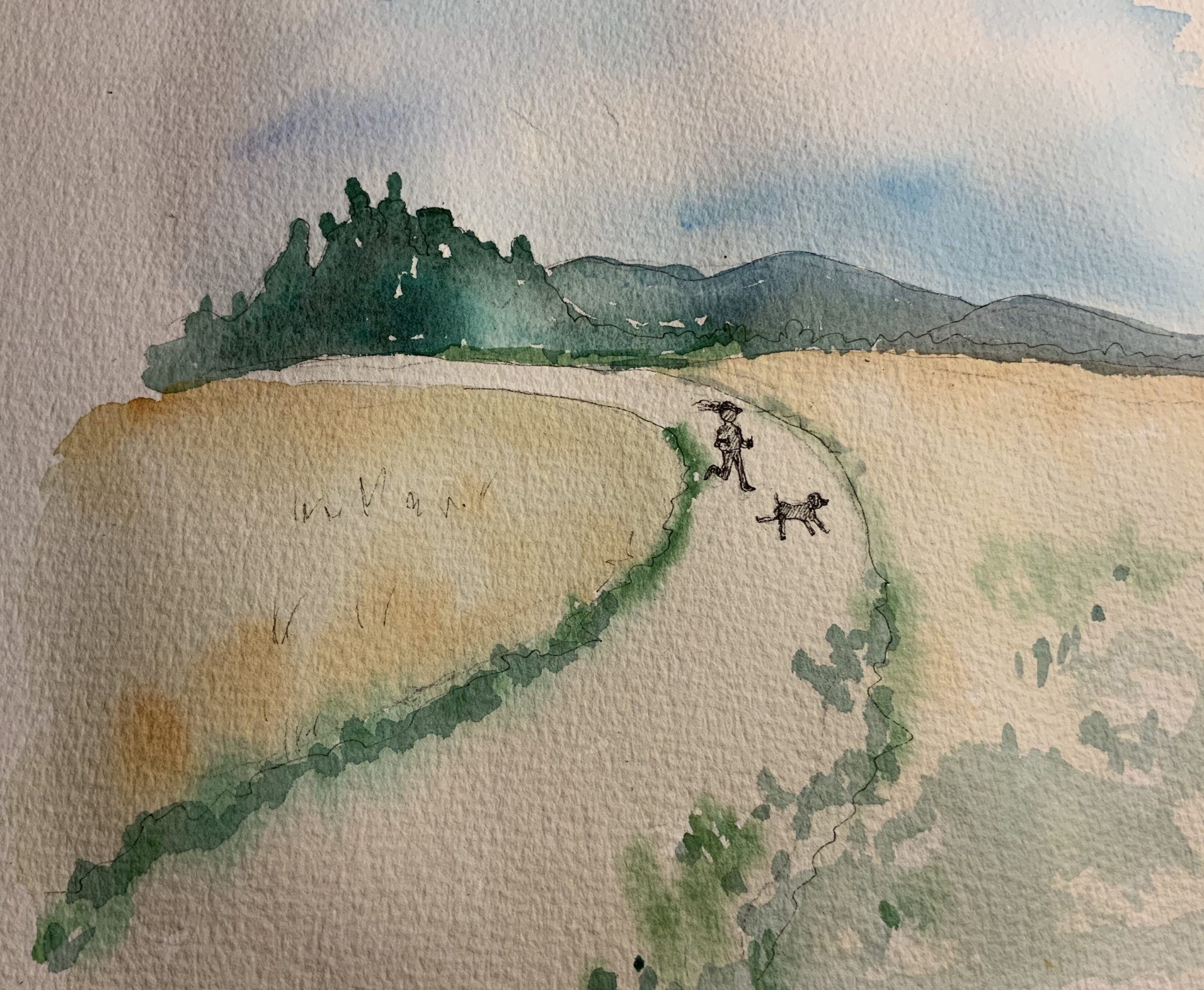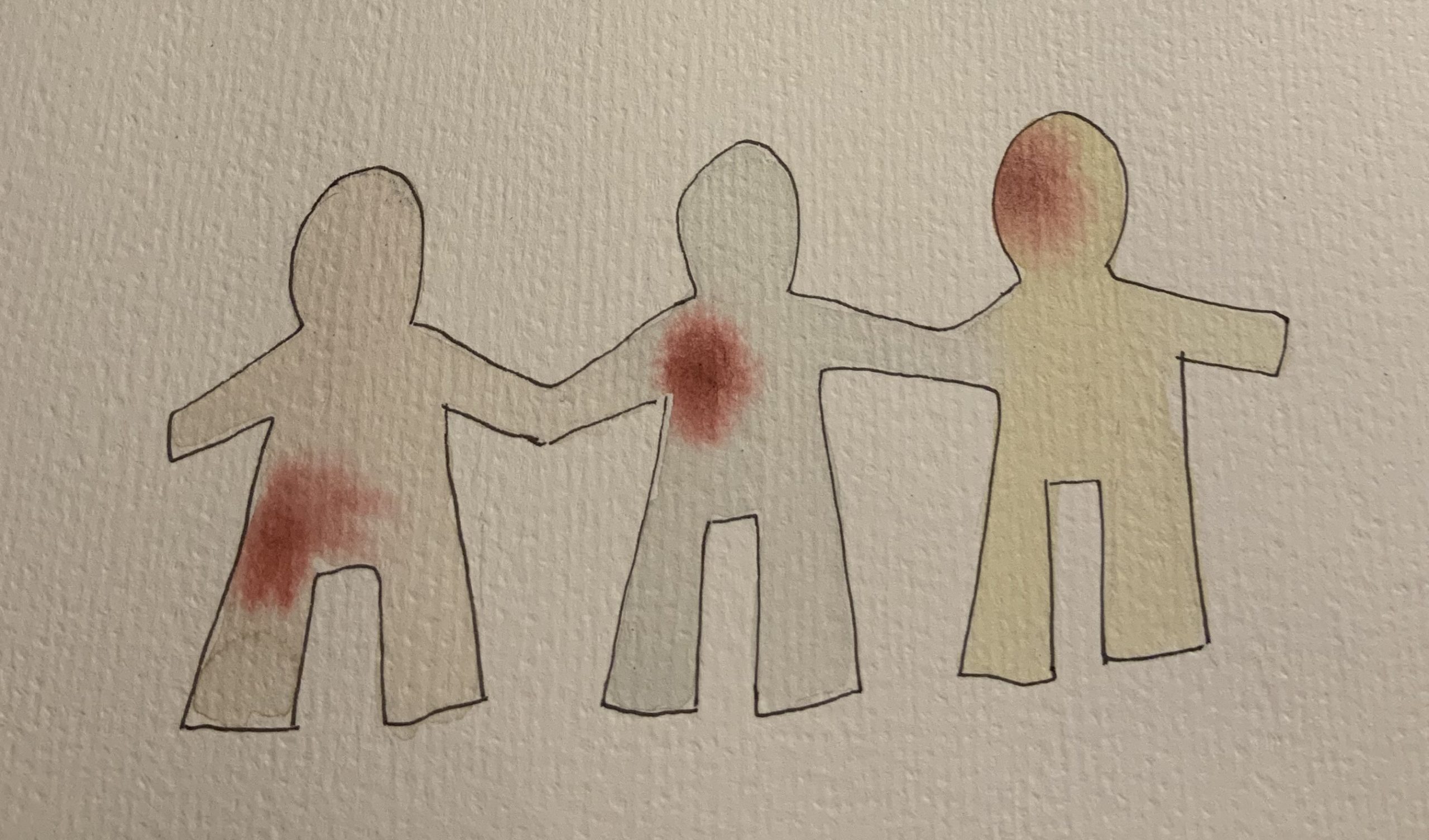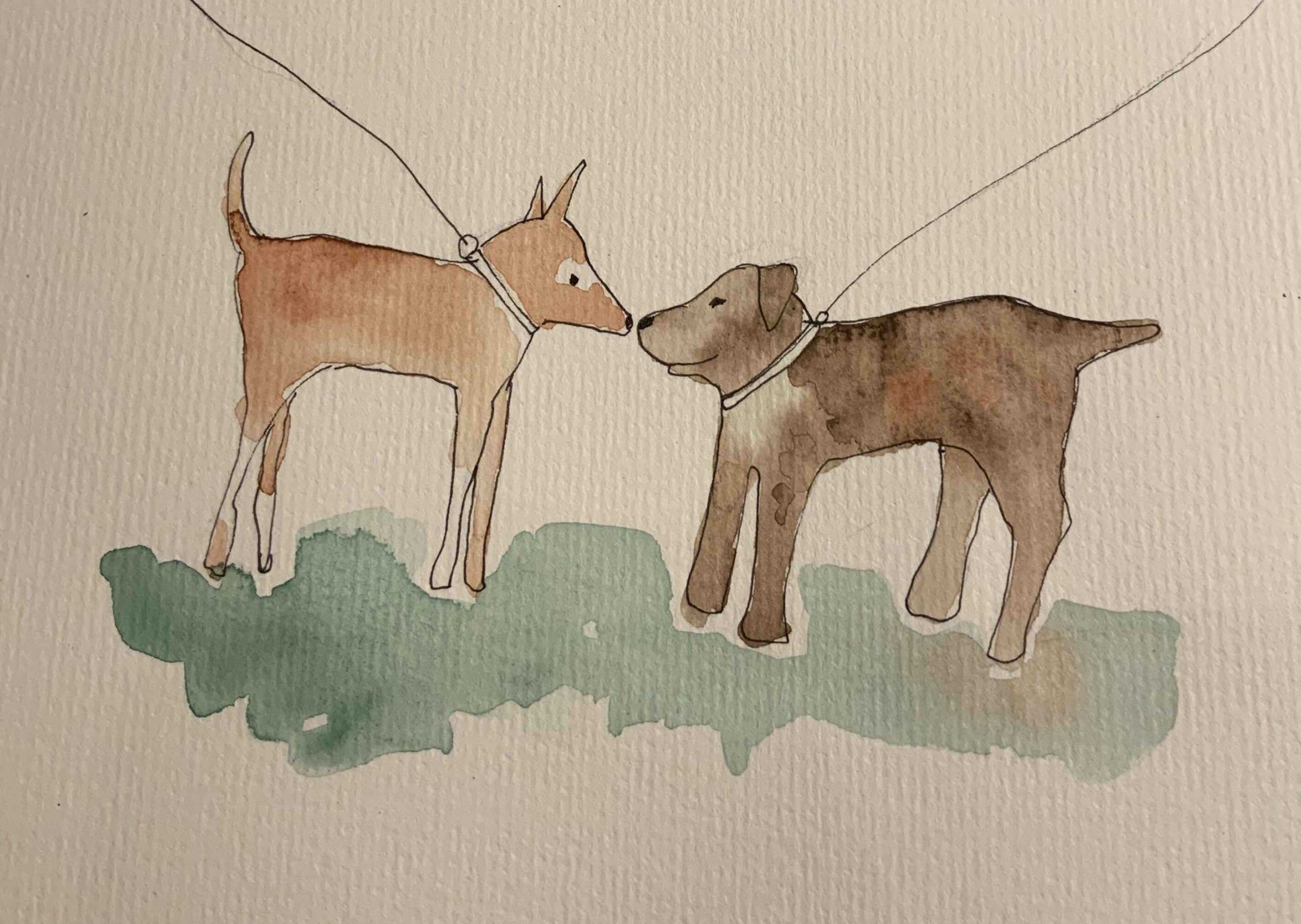I’m obsessed with a lump on my dog’s penis.
Maybe obsessed isn’t the right word. Maybe I’m simply paying appropriate daily attention to the marble-sized growth that’s technically on Barney’s prepuce, the sheath of skin and hair covering his lipstick colored penis. Maybe I’m doing what I always do when bad news threatens, preparing to power through whatever’s coming.
We all—that’s my partner, my teen son, and me—noticed the growth on our happy and rambunctious nine-year-old brindle pit bull when life began to slow, when schools closed, then restaurants and bars, and then my office, too. Before a mandatory shelter-in-place order and after we began to be aware of the circulating virus. Home all day, we had plenty of time to notice details we’d overlooked in our previous flurries of busy-ness.
So, the growth. On Barney’s penis. On the surface of the spherical lump are a couple of deeply purple spots that resemble blood blisters. They could be non-worrisome age-related changes in the skin or terribly worrisome malignant spots, a hemangiosarcoma or a melanoma. Despite Barney’s apparent health, the spots are now impossible to ignore on top of the shooter-sized marble.
I snap a few photos.
“Sorry,” I text my vet, “to bother you with my dog’s dick pics, but what do you think? Time to get it looked at?”
“Probably time to get it taken off,” he replies.
While I wait for the hard-to-get-into specialist appointment—it’s not like we can lop off his penis to get adequate margins if it’s cancerous, so surgery will be complicated enough to require a specialist—I apply topical solutions daily. Substances with scientific backing for reducing tumors (turmeric) and substances without (essential oils and a special honey). We all think the marble has shrunk, but we might be wishing.
Native habitat has shrunk out at the Sandy River Delta on the east end of Portland, where I’ve been walking with my dogs for over a decade. A mix of riparian woodlands and wetlands, the original hardwood forests were made up of black cottonwood, Oregon ash, willows, and dogwoods. The delta’s wetlands were once full of cattails, rush, and sedges, a critical rest area for migratory birds and a nesting ground for waterfowl. The sand deposits at the mouth of the river supplied spawning habitat for huge numbers of smelt and salmon that return annually to the Sandy River. When Lewis and Clark came upon the delta in 1805 they described in their journals an extraordinary landscape so thickly forested they could not walk through it. The fertile forest and wetland supported deer, elk, bobcats, sea otters, and so many birds and waterfowl the explorers complained: “I could not sleep at night… they were emencely (sic) numerous and their noise horrid.”
I discovered the delta in the early 2000s, seeking wide open spaces to walk with Nicholai, the dog who preceded Barney. The Sandy River Delta delivered; nearly fifteen hundred acres of open fields, marsh lands, overgrown dirt and gravel roads, a few footpaths, old broken-down corrals. Himalayan blackberries and reed canary grass grew everywhere amidst the cottonwood trees. Free to walk or run for over an hour and often see no other people, I could let big and somewhat grumpy Nicholai romp unrestricted. I slogged through marshy areas, water up to my knees. Threw sticks into ponds and puddles for the dog to retrieve. I sighted deer and coyotes, geese, ducks, and herons. I fell in love with the delta and walked there with Nicholai and later with Barney and our other dog, Kelley, most days of every week.
I discover that the mere act of tap-tapping letters to lay down on the page a description of Barney’s marble-sized growth tightens muscles between my shoulder blades, pulls the bones closer together, sneaks my shoulders toward my ears. I push back from my desk; I have to do something. I leave my computer and from the kitchen counter I grab a small Tupperware, flip the lid off, and crouch onto the floor beside my canine, snoring away in his favorite bed. He knows the drill, raises one eyelid and lazily lifts a back leg. Does the turmeric-coconut oil-baking soda salve relieve pain or discomfort? Is the salve reducing the size of the growth, or halting growth where it is? Sweet Barney trusts the person who has always fed him, taken him to romp at the Sandy River Delta, and snuggled with him under a cozy fleece blanket in front of a crackling fire on cold winter nights, so he allows me to once again smear my concoction onto his lump. I don’t know if I’m helping, but I will not be able to live with myself if I don’t try everything at my disposal.
My own cancer probably started like a blemish then grew to marble size, too. Inside, where no one could see it. It grew silently and slowly for a while, at the end of my sigmoid colon and the upper reaches of my rectum, unnoticeable until I started to shiver every time I had to poop. I complained but my doctor dismissed it—in my thirties, a vegetarian and runner, no red flags for colorectal cancer. Until the symptoms of diarrhea and constipation became compelling and we knew: there had to be a growth, a blockage.
Twenty-five years ago, the approach to cancer was pretty straightforward: slash, burn, poison. Surgery, radiation, chemotherapy. Treatments aimed at finding the sweet spot between killing cancer cells but not killing the patient. It didn’t always work.
In my case, radiation was applied to shrink the tumor, sterilize the field, and avoid the need for a life-altering surgery. While it may (or may not) have sterilized the field, major surgery was still necessary to ensure adequate margins. Oncologists insisted I follow up with a year of chemotherapy.
“We use a drug called fluorouracil. 5FU for short.” The doctor didn’t even blink. FU, too, I thought.
5FU has all the usual side effects—nausea, vomiting, malaise, skin irritation, hair loss, and a weakened immune system. It’s still in use today though medical research shows little statistical difference in survival between those treated with 5FU and those without for cancer the type and stage of mine. I opted out of chemo and embraced unproven but also non-toxic treatments like herbs and acupuncture.
The Sandy River Delta I embraced is not the one that overwhelmed Lewis and Clark with its teeming life, that was home and hunting ground to the Chinook people before that. The river was dammed in 1913 by Portland General Electric. In the 1940s, with World War II in full swing, the US Government built an aluminum plant beside the Sandy River, then sold it to Reynolds Metal company. Waste products—metals, fluoride, and cyanide—flowed into the surrounding area. Wastewater soaked into wetlands that drained into a lake and then into the Columbia River.
In the late 1940s the VanPort flood surged across the delta and wiped out the forest. Enticed by the newly opened land, a family named the Martins purchased the ravaged delta and began a ranching operation. But Reynolds Metals Company’s production methods had caused huge quantities of chemicals to absorb into the vegetation and contaminate the water. The Martins became sick. Their cows died. They successfully sued Reynolds Metals for damages but had to abandon the land. In the early 1990s, the US Environmental Protection Agency declared the Sandy River Delta a Superfund site. Superfund sites were first designated under the Comprehensive Environmental Response, Compensation, and Liability Act of 1980. To be designated a Superfund site, an area must be so polluted that it will require a long term effort (and a super amount of funds) to clean up the hazardous materials. Reynolds Metals worked from 1994 to 2006 to remove toxic waste.
I started walking my dogs at the delta in 2005. After Nicholai’s diagnosis of lymphoma in 2009, I walked with him out by the Sandy River every day until he died in 2010. I reveled in the wildness of the delta—and I like to think that my living-with-cancer dog did, too—chasing balls and sticks and geese and occasional deer. Limbs stretched long to dash across vast fields, ears flapping, mouth wide in grin. While Nicholai romped his last months, I didn’t yet know the delta’s history of industrialization, couldn’t see the pollution under every surface. Nature, though changed, survived and its wild beauty overwhelmed me.
“Mary,” my sister’s voice whispered through the phone lines over the miles between Montana and Oregon, “the lump is malignant. It’s breast cancer.”
My sister was healthier than she’d been in years. Exercising regularly, eating well, riding her bike to work. She’d lost twenty-five pounds and felt jazzed about life. Fifteen years out from my bout with colorectal cancer (and our brother twenty-five years out from a brain tumor), I felt a familiar steel course through my arteries and veins, strength against coming hardship. I jumped into Go mode. We Can Beat This mode. We Get Tumors But Don’t Die Of Them mode. I packed my car and not-yet-dead-from-cancer Nicholai, left my partner with our two kids and headed over rivers and mountain passes to lend a hand while my sister went through treatment after treatment. I did this over and over for eighteen months.
Barney’s veterinary specialist does not have good news. His penis-sheath tumor looks like tumors that, in her experience, are malignant blood cancers. The needle biopsy seems to confirm this, though we won’t know for sure until pathology makes their report. I’m not surprised. I’m not shocked. I’m steeled. I’ve long since ceased to think that this can’t happen to me. My chest tightens, a brace against the grief already rising behind my breastbone.
It turns out, you can lop off a dog’s penis, a penilectomy with a urostomy, the surgeon tells me. At these words, the me on the inside starts to flutter and blur. Fuzzy me wants to slip out the top of my head and float up to the ceiling. Lop off his penis? Urostomy? Rectal cancer resulted in a colostomy for me so I’m well aware of the management required to handle an abnormal opening for excretion; I wear a goddamn plastic pouch on my belly. I wonder if the vet is out of her mind. She reminds me that Barney’s ego isn’t attached to his penis the same way a human ego would be, and I know the truth of it. Still, I marvel at the brutality of cancer treatments, the damage and disfigurement we agree to in trade for our lives. The breasts and rectums and limbs and organs (penises?) we agree to let go of, the loss terrifying and horrible; the desire to keep living more compelling.
We were the Big Kids: Mary, Joan, and Bud. The oldest three of seven. From our ranch style house on the outskirts of Helena, Montana, we raced through the acre of weeds behind our acre of lawn, dashed down the old dirt road to the local nursery, crossed a rickety old wooden bridge over the Tenmile Creek. We climbed hills, rode horses, dodged prickly pear cacti and kept an eye out for diamond back rattlesnakes sunning on rocks or slithering along trails. On dry summer days with the bright mountain sun toasting our heads and shoulders, we dipped our feet into the creek. Walked upstream, our rubber-soled Keds gripping slippery river rocks. We bent over and splashed clear stream water in our faces. Laid on the banks, our stomachs pressed to dirt and thirsty mouths open to slurp up the fresh cold water of the Tenmile.
Tenmile Creek rises near the top of the Continental Divide on the east slopes of the Rocky Mountains. Flows are heaviest in late spring and early summer fed by snowmelt and spring rains. Hard rock mining was common in the upper Tenmile watershed from the late 1800s all the way into the 1990s so arsenic, cadmium, lead, copper, nitrate, phosphorus, and zinc release into the water as the stream flows through old mines and over tailings. The Tenmile creek supplies half the drinking water for the residents of Helena and still sometimes contains levels of arsenic, cadmium, and lead unsafe for human consumption.
A cluster of cancers began to develop along the course of the creek. Brain and other cancers an order of magnitude in excess of average statistics popped up in and around the old mining town of Rimini. The stream flows down from Rimini, past our childhood home, and into the Helena water treatment plant. In 1999, The EPA declared the Tenmile Creek Watershed to be a Superfund site. As of 2010 more than sixty-three million dollars had been spent on clean-up.
In 2011, heavy rains and snowmelt caused bright acidic orange water to flow out of the old mines and into the Tenmile Creek. Officials denied that the orange water posed any health risk. People living along the creek felt otherwise.
“I’m no geologist,” said one resident to the Helena Independent Record in June 2011, “but this doesn’t look good. Supposedly they cleaned it up, but what that stuff is, I sure don’t know.”
From my sister’s first intervention—the radical double mastectomy that removed both breasts along with lymph nodes and muscle tissue—feeling well and healthy never came back onto her table. One brutal treatment after another on an eighteen month march to death. On those days when I’m particularly missing her, I wonder: would she have lived just as long without treatment at all? Longer? Been able to take that trip to Hawaii she longed for? It’s all a moot point now. Except it isn’t.
Barney’s curled into a ball, an inflatable pillow around his neck, his nose tucked inside the fuzzy bolster of his favorite faux-sheepskin bed. I’m on dog-watch as I write, letting him out when he wants to go out and bringing him in, usually before he wants to come in. Even with the blow-up collar, I need to supervise him, keep him from licking or scratching at any pain or itch around the stitches of the recent incision on the penis he got to keep. The vet and I agreed not to do the penilectomy—radical, disfiguring, and possible to cause permanent issues that would mess with a dog’s quality of life..
After his surgery, the vet and I stood in the parking lot under a bright blue sky instead of meeting in a treatment room. From six or eight feet away, she shielded her eyes from the bright noon sun while she assured me that pathology results will come soon. There’s still a chance the lump was benign. If so, my relief will ride out on a tsunami sigh because the prognosis, even with surgery, for blood cancers is dire: two years if the cancer hasn’t spread to the subcutaneous tissue below the skin; only six months if it has.
While Barney recovers, I take Kelley, the currently healthy dog, for a leash walk at Portland’s Mount Tabor Park. The park, an extinct volcano, is full of walkers and runners and cyclists and dogs, all six feet or more apart from each other in this time of separation; easy in the vast expanse of city park. At one point, I let my well dog stray toward a short, gray pit bull mix next to her man. Squat and wide with a bunched-up nose, she looks like a little gray pig and I laugh out loud.
“Oh my gosh, she’s so cute!”
“She’s friendly,” her owner replies.
“So’s mine.”
We let our leashed dogs edge closer, finally nose to nose. This is how we can connect, this stranger and I, in a time of distance and no touching: six-foot lead to dog to nose to nose to dog to six-foot lead. When I’m face to face with the scourge of cancer once again and when a virus has us all flat up against our mortality and the fragile state of earth, these tiny moments of connection are everything. The steel I use to defend myself against loss softens, and that brace that tightens around my chest in times of loss begins to open. My defensiveness has never been what’s saved me.
Barney will recover from surgery. His wound will heal and stitches come out, and he’ll be jonesing for longer walks and off-leash romps. I, too, will tire of micromanaging for safety. But what shall I do—when Barney’s better and the pandemic has passed—to let the two dogs and myself romp freely? Return to the Sandy River Delta with its still-contaminated soil? Or shall I seek another place—a trail along the mighty Columbia, perhaps, where invisible remnants from closed Hanford nuclear plant may still live their endless half-lives? Maybe we can walk along the banks of Portland’s Willamette River, yet another Superfund site that extends ten miles from downtown Portland to the confluence with the Columbia and where signs warn those fishing that it’s okay to fish but not safe to eat fish from the Willamette or its sloughs more than once per month. It’s not just this virus. The environment hasn’t been truly safe or clean in my lifetime.
With extra vigilance, I wipe Barney’s belly and inner thighs with a damp cloth after he’s been outside, clean remnants of dirt and invisible pollutants from his skin, apply a healing salve. It’s all I’ve got, these daily acts of love and hope. As usual, he rolls over and submits to my ministrations. He doesn’t lick the salve away like I’d expect, and when I’m done he simply curls into a ball, tucks his nose under his paws, and closes his eyes. I kiss the top of his furry head then set the salve on the kitchen counter, ready for its next use.
When he’s better, I’ll return to all the places: the Sandy River where cottonwood trees smell sweet and what’s left of the invasive blackberries after colossal repair and replanting efforts turn juicy and ripe in summer. Trails along the Columbia River where the river’s wide and the sky wider as it rumbles toward the sea. The Willamette River, where eagles and herons nest, where mergansers and mallards swim and quack and where it’s now safe enough to swim in places after massive efforts at clean-up. Nature is scarred and blemished like Barney and like me. Yet changed, damaged even, we survive. Wild in our beauty.
***
Rumpus original art by Susan Ito.
